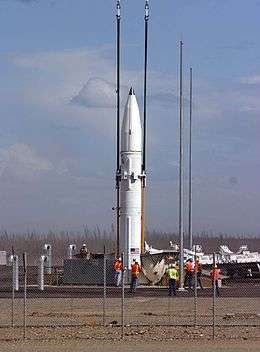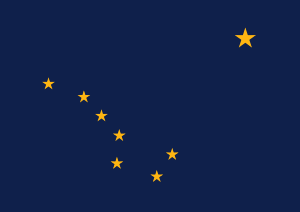Fort Greely

Fort Greely is a United States Army launch site for anti-ballistic missiles located approximately 100 miles southeast of Fairbanks, Alaska. It is also the home of the Cold Regions Test Center (CRTC), as Fort Greely is one of the coldest areas in Alaska, and can accommodate cold, extreme cold, or temperate weather tests depending on the season. It is named in honor of Major General Adolphus Greely.
There was an earlier Fort Greely on Kodiak Island.[1]
History
The early years
The camp was established in 1942 as Big Delta Army Air Field. During World War II, The Alaska Highway was built to connect an existing road in Dawson Creek, British Columbia, Canada with the Richardson Highway in Alaska, a distance of 1,423 miles (2290 km). The Alaska Highway met the Richardson Highway at Delta Junction, five miles (8 km) north on the Richardson Highway from what is now Fort Greely. The United States used the base to aid Russia against Germany and Japan by sending airplanes and supplies authorized by the Lend-lease act through Alaska and into the Russian Far East. The name was later changed to Allen Army Airfield. After World War II, Fort Greely was built south of the air field.
After World War II, the War Department decided that an American soldier must be able to live and operate in any degree of cold.[2] This decision was based on experience gained in combat and predictions of future possibilities for international obligations. A group of task forces was therefore organized to test U.S. Army equipment in the cold. Task Force Frigid and Task Force Williwaw were dispatched to Alaska during the winters of 1946 and 1947. A related trial unit, Task Force Frost, incorporated elements of the 66th Armor Regiment and underwent tests in Camp McCoy, Wisconsin at roughly the same time.[3]
Settling in
The information and data collected by task force personnel was a beginning, but it took time for men to be transported, to set up quarters for a short period of actual testing, and then pack up and leave until the next year. The expense of moving in and out was taken into consideration when the final reports were filed. When questions arose concerning the reports, there was no one available to answer them, for the task forces had been disbanded, and the personnel returned to their home units. The major shortcomings of these task forces included having insufficient time to establish units on test sites, the lack of acclimatization period for both personnel and equipment and a lack of continuity. Based on these results, it was recommended that a permanent test organization be established, with test groups representing each of the "Army Field Force Boards" located in the "Zone of the Interior."
In 1949, the Department of the Army ordered the organization of the Arctic Test Branch at Big Delta Air Force Base, Alaska (now known as Fort Greely). A cadre for the organization was activated at Fort Knox, Kentucky, in March 1949, by the transfer of personnel from each of the "Army Field Force Boards." The organization moved to Alaska in July 1949 and test operations were initiated. Shortly thereafter, the organization name was changed to the Arctic Training Center. In 1957, it was renamed the U.S. Army Arctic Test Board, with the mission of conducting Arctic service tests of all Army field equipment.
From 1955, Fort Greely and a huge tract of land around it (withdrawn from the Department of the Interior) were used for training soldiers for cold weather combat during the Cold War with the former Soviet Union.
In the early 1960s, the Army constructed a nuclear electrical power plant, SM-1A, at Fort Greely as part of the Army Nuclear Power Program which included similar operational plants in Antarctica, Greenland, the Panama Canal Zone, Virginia and Wyoming. The initial operators at Fort Greely were military NCOs, but civilians were later hired. The plant operated until 1972.[4]
In August 1962, as a result of the reorganization of the Army, the Arctic Test Board was established as a Class II activity and placed under the command of the U.S. Army Test and Evaluation Command (TECOM). The Board was later renamed the Arctic Test Center and expanded to absorb the Research and Development Office, Alaska, the Technical Services Test Activity, and the General Equipment Test Branch, all located at Fort Wainwright, Alaska, and the Chemical Corps Test Activity at Fort Greely. In 1976, the U.S. Army Arctic Test Center was re-designated the U.S. Army Cold Regions Test Center.
The modern era
In 1991, when the Cold War ended with the collapse of the Soviet Union, Fort Greely was realigned through a gradual draw-down in the numbers of soldiers.
In 1995, Fort Greely was selected for realignment (but not closure) as a cost-saving measure. Only the Cold Regions Test Center (CRTC) and Public Works functions were to remain on the installation. Large portions of the post were to be closed and, at one point, the main post was to be turned over to the city of Delta Junction for use as a private prison. Ultimately, plans for the prison fell through. In 2001, headquarters for the Northern Warfare Training Center and Cold Regions Test Center were moved to nearby Fort Wainwright. Training ranges were also transferred to Fort Wainwright control and renamed Donnelly Training Area. Although its command moved, CRTC continued operating from Fort Greely. The Northern Warfare Training Center also continued operations at Black Rapids Training Facility.
After the United States announced that it would withdraw from the Anti-Ballistic Missile Treaty, Fort Greely was selected as a site for the Ground-Based Midcourse Defense system. Starting in the summer of 2002, the United States government began work on the missile defense installation at Fort Greely, planning to deploy a total of 25 to 30 anti-ballistic missiles by 2010. Concurrently, the Missile Defense Command took command of Fort Greely, relinquishing direct Army control, while the Army retained control of the nearby Donnelly Training Area.
In 2005, the CRTC headquarters was moved from Fort Wainwright back to Fort Greely. Though testing efforts remain centered at the Bolio Lake Range Complex - now part of Fort Wainwright - numerous support functions remain on Fort Greely's Main Post.
In December 2014, Congress approved $50 million as part of the $1.1 trillion spending plan to increase the number of interceptor missiles at Fort Greely from 26 to 40 as part of a missile-defense expansion announced in 2013.[5]
With the continued development of an intercontinental ballistic missile program by North Korea, Fort Greely may be slated for an expansion. Fort Greely is currently one of the two U.S. sites housing anti-ballistic missile interceptor missiles, and it is located near the Great circle line from North Korea to the continental United States. Expansion of its capabilities may be required to protect Alaska and the West Coast of the United States from possible North Korean attacks.[6]
See also
References
- ↑ Stevens, Joe (7 April 2016). "Kodiak Alaska Military History". www.kadiak.org. Kodiak Military History Museum. Retrieved 5 July 2016.
- ↑ "History". Cold Region Test Center. United States Army. n.d. Retrieved 5 July 2016.
- ↑ "66th Armored Regiment". www.2ndarmoredhellonwheels.com. 2nd Armored Division Association. n.d. Retrieved 5 July 2016.
- ↑ United States Department of Energy (January 2001). "Appendix D: Military reactors". Highly Enriched Uranium (PDF) (Report). p. 147. Retrieved 5 July 2016.
- ↑ "Fort Greely to get $50 million toward missile defense system". Army Times. Associated Press. 16 December 2014. Retrieved 5 July 2016.
- ↑ Bumiller, Elisabeth; Sanger, David E. (12 January 2011). "Gates Warns of North Korea Missile Threat to U.S.". The New York Times. Retrieved 5 July 2016.
External links
- Fort Greely Homepage (official site)
- Fort Greely History (official site)
Coordinates: 63°54′30″N 146°14′57″W / 63.90833°N 146.24917°W
